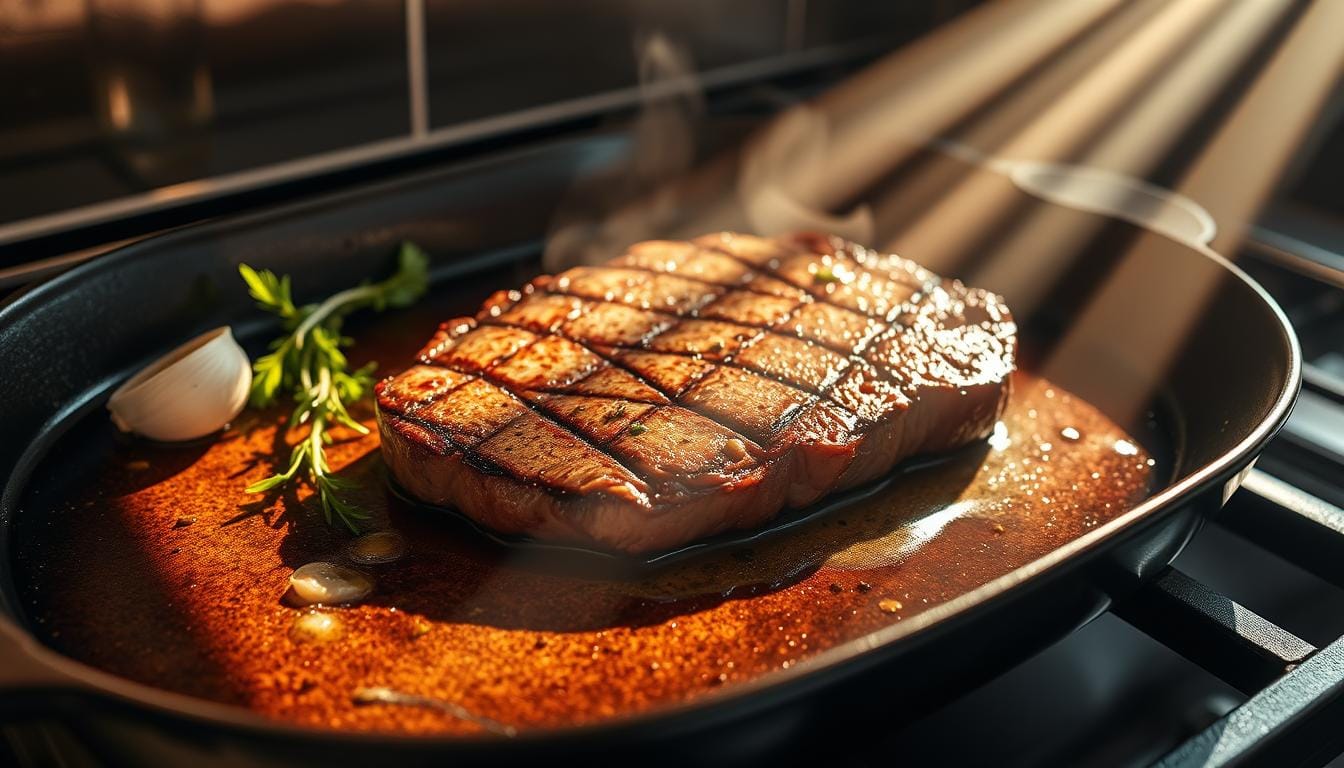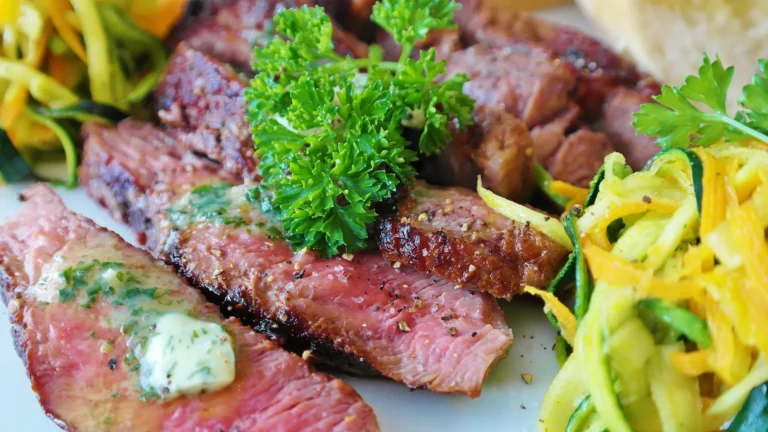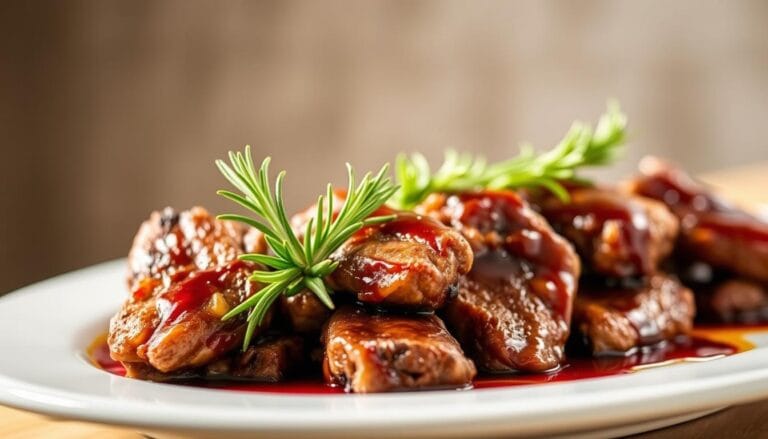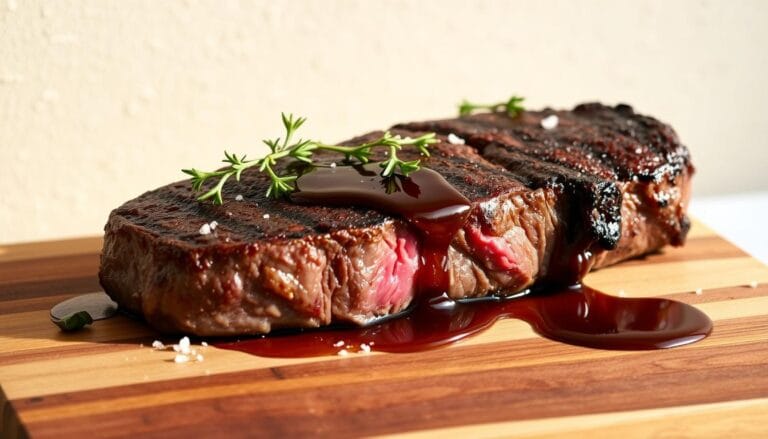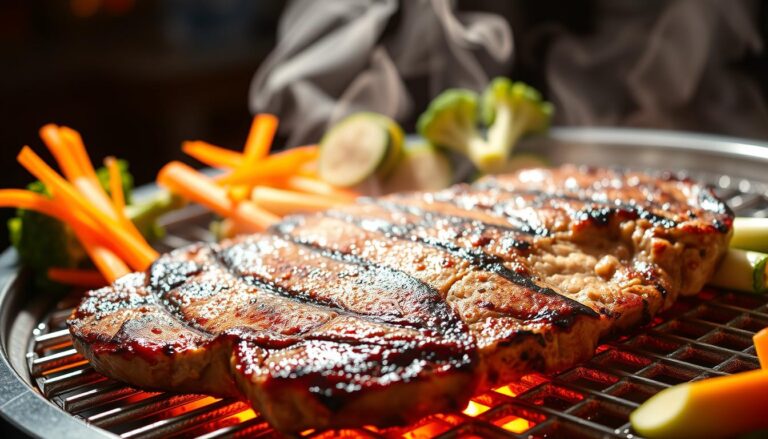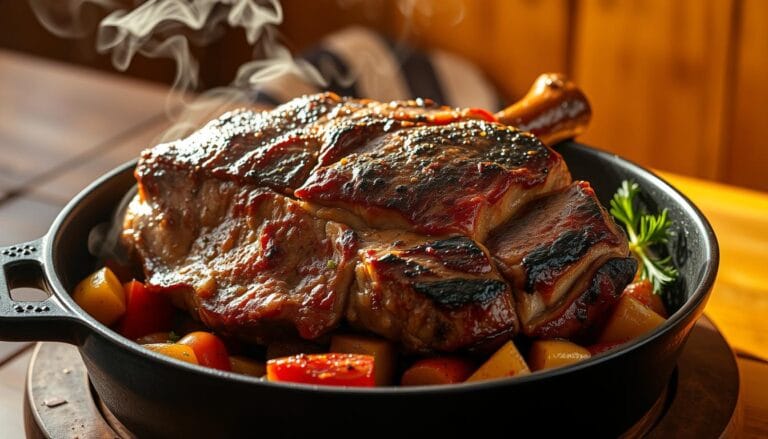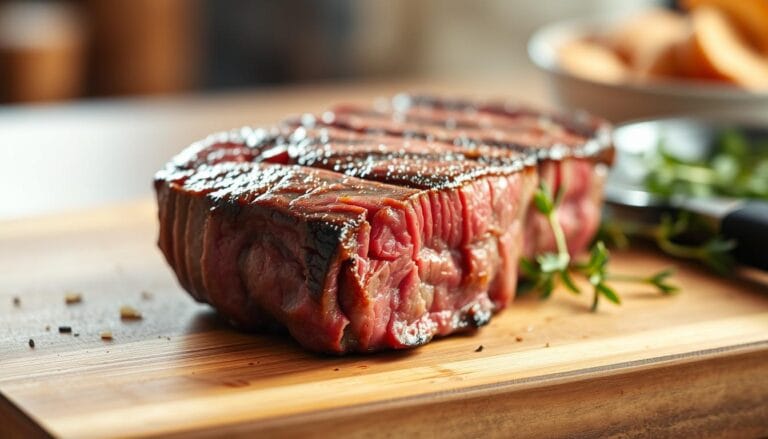How to Cook Steak on Stove for Juicy, Flavor-Packed Bites
Table of Contents
How to Cook Steak on Stove for Juicy, Flavor-Packed Bites
Cooking strip steak on the stove can make your meals feel like a fancy restaurant. It’s different from grilling because you can control the heat. This means you’ll always get a steak that’s just right.
Strip steak is special because it’s both flavorful and tender. Learning to cook it on the stove opens up a whole new world of taste. You’ll get a crispy outside and a juicy inside.
In this article, you’ll learn how to pick the best strip steak. You’ll also find out how to prepare it and serve it to wow your guests. Whether you’re an expert in the kitchen or just starting out, you’ll become a pro at cooking strip steak.
Key Takeaways
- Learn the benefits of cooking strip steak on the stove.
- Understand how to select the perfect strip steak.
- Discover techniques for achieving a perfectly cooked steak.
- Explore tips for serving and presenting your dish.
- Gain confidence in cooking strip steak like a professional.
Understanding Strip Steak and Its Flavor Profile
Learning about strip steak is key to getting juicy, flavorful bites on the stove. This cut from the short loin of the cow is known for its tenderness and rich taste.
What is Strip Steak?
Strip steak, also known as New York strip or Kansas City strip, is famous for its good marbling. This marbling makes it tender and flavorful. American steaks are usually 1-1.5 inches thick and have a rectangular shape.
The marbling adds to the tenderness and flavor. This is why it’s a favorite among steak fans.
Why Choose Strip Steak?
Choosing strip steak for stovetop cooking has many benefits. Its balanced fat content makes it easy for home cooks. It allows for a nice sear without overcooking the inside.
The robust beefy flavor of strip steak also works well with high-heat cooking. This ensures a delicious crust on the outside and a juicy inside. Plus, it’s more affordable than cuts like ribeye or filet mignon, making it a great value.
Culinary experts say, “The key to a great steak is not just the quality of the meat, but also the technique used in cooking it.” Strip steak’s characteristics make it perfect for stovetop cooking. It offers a satisfying and flavorful culinary experience.
Preparing Your Strip Steak
To get a perfectly cooked strip steak, preparation is key. This means following a few important steps. These steps make sure your steak tastes great and is cooked just right.
Selecting Quality Strip Steak
When picking a strip steak, look for good marbling. It makes the steak tender and flavorful. The steak should be bright red and firm to the touch.
Choosing USDA Choice or Prime grade is a good idea. It promises a better dining experience. Aim for a steak that’s 1 to 1.5 inches thick for stovetop cooking. You can choose between bone-in and boneless steaks. Bone-in steaks might taste better because the bone keeps the meat warm.
Essential Tools and Equipment
A heavy-bottomed pan, like a cast iron skillet, is key for a perfect sear. You’ll also need tongs for flipping, an instant-read thermometer, and a timer. Using the best cast iron skillet for steak can greatly improve your steak’s quality.
Seasoning Your Steak
Seasoning is a must to boost your strip steak’s flavor. Begin with salt and pepper. For more complex tastes, try garlic, herbs, or compound butters.
Season your steak at least 40 minutes before cooking for better flavor. But seasoning right before cooking works too. Remember, too much salt can change the taste a lot.
Cooking Techniques for Strip Steak
To make a delicious pan-seared steak, you need to know the right cooking techniques. Cooking a strip steak on the stove is more than just throwing it in a pan. It’s about understanding the techniques that make the dish great.
Searing: The Key to Flavor
Searing is key in cooking strip steak. It creates the flavorful brown crust, known as the Maillard reaction. This happens when amino acids and sugars react with heat, making new flavors.
To get a perfect sear, your pan must be hot. Try flicking water on the pan; if it sizzles, it’s ready. Pat the steak dry with a paper towel before searing to get a crisper crust. Once in the pan,minimal movement is key. Let it cook undisturbed for a few minutes on each side for that perfect sear.
Using the Right Cooking Oil
The type of cooking oil you use can greatly affect your steak’s flavor and quality. Oils likeavocado oil,canola oil, orclarified butter are best for high-heat cooking. They can handle the heat without burning or smoking, giving a clean and flavorful sear.
Regular butter, with its low smoke point, can burn easily. It’s best to add it towards the end to add its rich flavor. Knowing about different cooking oils helps you make better choices, improving your cooking.
Mastering searing and choosing the right oil can greatly improve your pan-seared steak. These basic skills are the foundation of your cooking skills. They ensure your strip steak is always flavorful and perfectly cooked.
The Perfect Cooking Temperature
To cook a strip steak just right, you need to get the temperature just right. It’s not just about how long you cook it. You also need to know the steak’s internal temperature.
Understanding Doneness Levels
Doneness levels vary from rare to well-done, each with its own taste and temperature. Here’s a quick guide:
- Rare: Internal temperature of 120°F – 130°F (49°C – 54°C). The steak is red and juicy, with a warm red center.
- Medium-Rare: Internal temperature of 130°F – 135°F (54°C – 57°C). It has a hint of pink in the center.
- Medium: Internal temperature of 140°F – 145°F (60°C – 63°C). The center is slightly pink.
- Medium-Well: Internal temperature of 150°F – 155°F (66°C – 68°C). It has a slight hint of pink.
- Well-Done: Internal temperature of 160°F – 170°F (71°C – 77°C). It’s fully cooked with no pink color.
Remember, the steak will keep cooking a bit after it’s off the heat. This is called carryover cooking. So, take it off the heat when it’s a bit under your desired temperature.
Using a Meat Thermometer
A meat thermometer is key for perfect doneness. It makes sure you get it right every time. There are many types, like instant-read and leave-in digital thermometers.
To use it right, put the thermometer in the thickest part of the steak. For strip steak, that’s usually the center. Check the temperature as you cook, near the end.
Tips for Using a Thermometer:
- Choose a thermometer that fits your needs, whether instant-read or leave-in.
- Regularly calibrate your thermometer for accuracy.
- Don’t press down on the steak with your spatula while it’s cooking, as this can push the thermometer out of place.
With a good understanding of doneness levels and a meat thermometer, you’ll always cook your strip steak perfectly.
Cooking Strip Steak on the Stove
Stovetop cooking is perfect for strip steak. It lets you control the cooking process well. You can get a steak with a tasty crust and a juicy inside.
Step-by-Step Instructions
To cook strip steak on the stove, follow these steps:
- Bring the steak to room temperature for even cooking.
- Pat the steak dry with paper towels to remove excess moisture.
- Heat a skillet or cast-iron pan over high heat until it smokes.
- Add a small amount of oil to the pan, just enough to coat the bottom.
- Place the steak in the pan and sear for 3-4 minutes per side, depending on the thickness.
- Use a meat thermometer to check for doneness. For medium-rare, the internal temperature should be around 130°F to 135°F.
- Once cooked to your liking, remove the steak from the pan and let it rest.
The cooking time may vary based on the steak’s thickness and your desired level of doneness. Here’s a general guideline:
| Steak Thickness | Medium-Rare | Medium | Medium-Well |
|---|---|---|---|
| 1 inch | 4-5 minutes per side | 5-6 minutes per side | 6-7 minutes per side |
| 1.5 inches | 5-6 minutes per side | 6-7 minutes per side | 7-8 minutes per side |
Tips for Even Cooking
To achieve even cooking, consider the following tips:
- Manage Hot Spots: If your pan has hot spots, rotate the steak to ensure even cooking.
- Spoon Basting: Use a spoon to baste the steak with hot oil or melted butter during cooking. This enhances flavor and promotes even browning.
- Cooking the Fat Cap: If your steak has a fat cap, consider cooking it on the fat side down for a minute or two to render some fat, then flip it over.
- Avoid Overcrowding: Cook steaks one at a time if necessary, to avoid overcrowding the pan, which can lower the pan’s temperature.
By following these steps and tips, you’ll be able to cook a delicious strip steak on the stove that’s sure to impress.
Resting Your Steak
Resting your steak is key to getting that perfect, juicy bite. After cooking your strip steak on the stove, it’s hard to wait. But waiting is important.
Importance of Resting
Resting lets the juices spread evenly, making each bite full of flavor. When you cook a steak, the heat pushes juices to the surface. Letting it rest helps these juices spread, making the steak juicier and tenderer.
Carryover Cooking: Resting also helps the steak cook a bit more. This is called carryover cooking. It ensures the steak reaches your desired doneness without getting overcooked.
How Long to Rest
The resting time depends on the steak’s thickness. A strip steak usually rests for 5 to 10 minutes. Here’s a simple guide:
| Steak Thickness | Resting Time |
|---|---|
| 1 inch | 5 minutes |
| 1.5 inches | 7-8 minutes |
| 2 inches | 10 minutes |
To rest your steak, take it off the heat and cover it loosely with foil. This keeps it warm without steaming. Don’t wrap it too tight, or it might sweat and lose its crust.
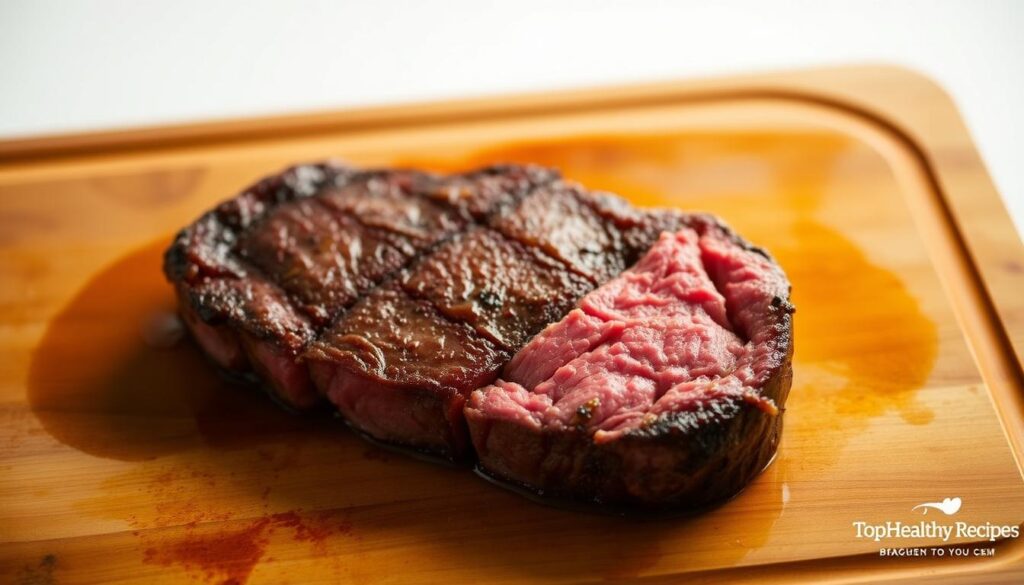
Adding this resting time to your cooking routine will greatly improve your steak. It makes for a truly satisfying meal.
Enhancing Flavor with Sauces
A good sauce can make your pan-seared strip steak even better. Sauces let you change up your meal, from classic to new and exciting.
Recommended Sauces for Strip Steak
Many sauces go great with strip steak, boosting its flavor. Try peppercorn sauce, béarnaise, chimichurri, red wine reduction, and compound butters. Each sauce adds a special taste that can make your steak stand out.
- Peppercorn Sauce: Gives a gentle kick and matches the steak’s char.
- Béarnaise: A French classic that adds richness and class.
- Chimichurri: An Argentine sauce that brings freshness and zest.
- Red Wine Reduction: Deepens the steak’s flavor with a fruity taste.
- Compound Butters: Softened butter mixed with things like garlic or parsley, for a fancy finish.
| Sauce | Main Ingredients | Flavor Profile |
|---|---|---|
| Peppercorn Sauce | Peppercorns, cream, butter | Spicy, creamy |
| Béarnaise | Butter, eggs, herbs | Rich, tangy |
| Chimichurri | Parsley, oregano, garlic, vinegar | Fresh, herby |
Homemade Sauce Ideas
Creating your own sauce is fun and lets you customize flavors. Here are a few easy recipes to start with:
For a quick sauce, use red wine or broth to deglaze your pan. Then, add butter to make it richer. Season with salt, pepper, and herbs to taste.
Try a garlic butter for something simple. Mix softened butter with garlic, parsley, and lemon juice. This adds a deep, aromatic flavor to your steak.
Pairing Side Dishes
To make your strip steak dinner special, try these side dishes and wine pairings. They enhance the steak’s rich taste.
Best Sides for Strip Steak
There are many side dishes to choose from, but some classics go great with strip steak. Here are some ideas, sorted by type:
- Starches: Roasted potatoes, mashed potatoes, or rice pilaf soak up steak juices well.
- Vegetables: Roasted asparagus, sautéed mushrooms, or creamed spinach offer a healthy contrast to the steak.
- Salads: A wedge salad or arugula with lemon vinaigrette refreshes the palate after savory steak.
These sides can be made while your steak cooks or rests. This makes for a smooth and enjoyable meal.
Wine Pairing Suggestions
The right wine can take your strip steak dinner to the next level. For a best cast iron skillet steak, try Cabernet Sauvignon, Malbec, or Syrah. These wines match the steak’s bold flavors with their strong tannins and dark fruit notes.
If you prefer not to drink wine, a sparkling water with lemon or a fruity juice can clean your palate between bites.
Common Mistakes to Avoid
Even the most skilled cooks can make mistakes when cooking strip steak. Knowing these errors can help you cook a better steak. Cooking a perfect pan-fried steak needs focus and understanding of common mistakes.
Overcooking the Steak
One big mistake is overcooking the steak. It’s key to know when your steak is almost done. Also, remember that the steak will cook a bit more after it’s taken off the heat.
Using a meat thermometer helps avoid overcooking. For a medium-rare steak, aim for an internal temperature of 130°F to 135°F.
| Doneness Level | Internal Temperature (°F) |
|---|---|
| Rare | 120-125 |
| Medium Rare | 130-135 |
| Medium | 140-145 |
Neglecting Seasoning
Another big mistake is not seasoning the steak right. Not seasoning enough or seasoning too late can ruin the flavor. Salting too close to cooking time doesn’t let flavors soak in well.
Proper seasoning brings out the steak’s natural taste without making it too salty. Season your steak at least 45 minutes before cooking. This lets the seasonings soak into the meat.
Other mistakes include cooking steak straight from the fridge, overcrowding the pan, and flipping the steak too much. Knowing these mistakes helps you avoid them. This way, you can cook a perfectly pan-fried steak.
Storage and Reheating Tips
After cooking your strip steak on the stove, it’s key to know how to store and reheat leftovers. This way, you can enjoy your meal again without losing flavor or compromising food safety.
Proper Storage Techniques
First, let your cooked strip steak cool down to room temperature within two hours of cooking. This step is vital to prevent bacterial growth.
Once cooled, slice the steak against the grain. Then, place it in an airtight container or wrap it tightly with plastic wrap or aluminum foil. Make sure to label the container with the date and store it in the refrigerator.
Cooked strip steak can safely stay in the refrigerator for 3 to 4 days. If you won’t eat it in this time, freezing is a good option.
| Storage Method | Duration | Notes |
|---|---|---|
| Refrigerator | 3-4 days | Store in airtight containers. |
| Freezer | 2-3 months | Wrap tightly in plastic wrap or aluminum foil, then place in a freezer bag. |
Reheating Without Losing Flavor
Reheating your strip steak correctly is as important as cooking it. There are several methods to reheat your steak without losing its flavor.
One effective method is using a low-temperature oven. Preheat your oven to 200°F (90°C), place the steak on a baking sheet, and heat until it reaches your desired temperature.
Another option is using a skillet on the stovetop over low heat. Add a bit of oil or butter to keep the steak moist. Sous vide reheating is also excellent, where you seal the steak in a bag and submerge it in hot water.
If you’re in a hurry, the microwave can be used. But be careful not to overcook. Heat the steak in short intervals, checking until it’s warmed through.
Another creative way to enjoy leftover steak is by repurposing it. Try making steak salads, sandwiches, or a breakfast hash.
Serving Suggestions
When serving strip steak, how you present it matters a lot. A good-looking dish makes the meal more fun for everyone.
Presentation Tips
To make your strip steak look great, slice it against the grain at an angle. This makes the steak tender and adds a pro touch to your dish.
Choose a plate that matches your steak’s color. A warm plate can make your best cast iron skillet steak look even better.
| Plating Technique | Description | Effect |
|---|---|---|
| Slicing Against the Grain | Slice the steak at an angle opposite to the muscle fibers. | Increases tenderness and visual appeal. |
| Balanced Composition | Arrange sides and garnishes around the steak. | Creates a visually appealing and balanced plate. |
| Temperature Control | Use warm or cold plates as appropriate. | Maintains the optimal temperature of the meal. |
Garnishing Your Steak
Garnishes can make your dish look and taste better. Try using finishing salts, fresh herbs, or compound butter coins on your strip steak.
For a crunchy touch, add crispy fried garlic or shallots on top. Microgreens are also a great choice, adding color and freshness.
Health Benefits of Strip Steak
Strip steak is more than just a tasty dish; it’s also good for you. Learning to cook a steak on the stove means you’re making a meal that’s healthy. It’s packed with nutrients that can help you stay well.
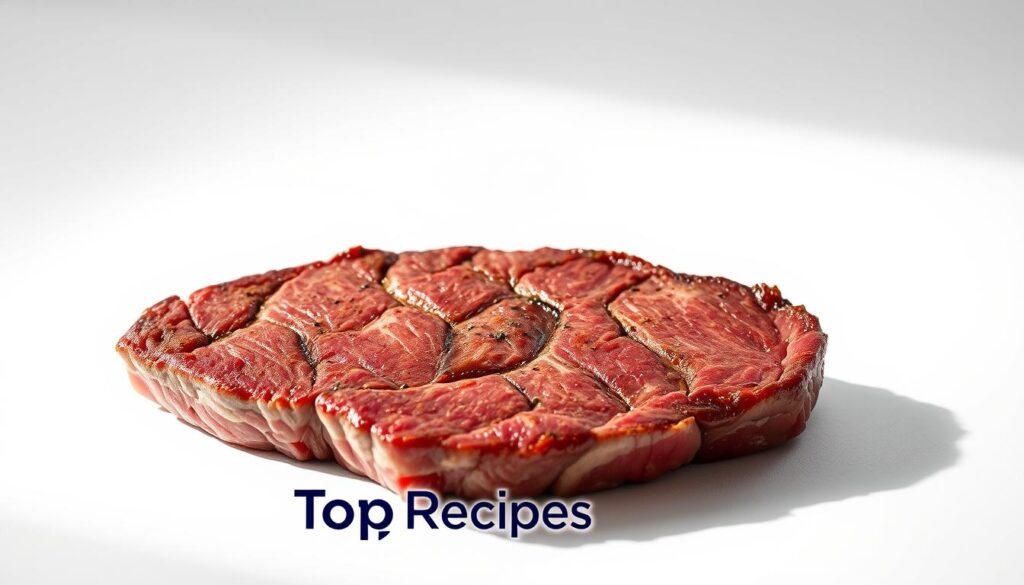
Nutritional Value
Strip steak is full of high-quality protein, which is key for muscles. A 3-ounce serving has about 22 grams of protein. It also has B vitamins, zinc, and iron, which are important for energy and health.
Strip steak has a mix of fats, but choosing lean cuts and trimming fat makes it healthier. A 3-ounce serving has about 200-250 calories, depending on the cut and how it’s cooked.
Lean Protein Benefits
The protein in strip steak helps keep muscles strong. It’s great for those trying to lose weight or build muscle. It also makes you feel full, which can help you eat less.
It’s important to eat strip steak in moderation. Aim for 1-2 servings a week. Eating it with veggies and whole grains makes your meals even better.
Knowing the health benefits of strip steak and how to cook it well lets you enjoy it while staying healthy.
Frequently Asked Questions
Now that you’ve learned how to cook strip steak on the stove, let’s tackle some common queries. These might help you perfect your technique and explore variations.
Cooking Time Guidelines
Cooking strip steak on the stove can be done to your desired level of doneness. The cooking time depends on the steak’s thickness and your preferred doneness.
| Steak Thickness | Rare | Medium-Rare | Medium | Well-Done |
|---|---|---|---|---|
| 1 inch | 4-5 minutes | 5-6 minutes | 7-8 minutes | 10-12 minutes |
| 1.5 inches | 6-7 minutes | 7-8 minutes | 9-11 minutes | 14-16 minutes |
Remember, these times are just guidelines. It’s essential to use a meat thermometer. This ensures your steak is cooked to a safe and desirable doneness.
Grilling Strip Steak: An Alternative Method
While pan-searing is great for cooking strip steak, grilling is another excellent method. Grilling adds a smoky flavor to your steak. To grill, preheat your grill to high heat and oil the grates to prevent sticking.
Key differences between grilling and pan-searing include:
- Grilling gives a charred exterior, while pan-searing provides a crispy crust.
- Grilling can be done with less oil compared to pan-searing.
- The smoky flavor from grilling can complement the natural flavors of the steak differently than the sear from a pan.
To grill strip steak, preheat your grill to high heat, season the steak as desired, and grill for 4-6 minutes per side. Cook until it reaches your desired doneness. Let it rest before serving.
Whether you choose to pan-sear or grill your strip steak, the key to a delicious meal is in the details. From seasoning to resting, each step contributes to the final flavor and texture.
Conclusion: Enjoy Your Delicious Strip Steak
Learning to cook strip steak on your stovetop is a great skill. It makes your cooking better. The secret to a tasty strip steak is in how you prepare it, cook it, and practice.
Reflect on Your Experience
Think about what went right and what you can do better next time. This thinking helps you get better at cooking, like with strip steak.
Experiment with New Recipes
After mastering the basics, try new things. Mix up your seasonings, sauces, and how you present your steak. This is where cooking gets really fun. Try different sides or cooking ways to find your favorite.
Now, it’s time to use what you’ve learned. Cook for your loved ones and enjoy the yummy results.
FAQ
How long should I cook strip steak on the stove?
Can I use a non-stick pan to cook strip steak?
How do I prevent overcooking my strip steak?
What is the best oil to use for pan-searing strip steak?
Can I cook strip steak from frozen?
How do I achieve a good sear on my strip steak?
What are some recommended sauces to serve with strip steak?
How should I store leftover strip steak?
Can I reheat strip steak without losing its quality?
For more cooking tips, stay connected with us. We also recommend the cookbook Skinnytaste Simple: Easy, Healthy Recipes with 7 Ingredients or Fewer
For more Recipes about Steak ?
Did You try our recipe ?
There are no reviews yet. Be the first one to write one.
